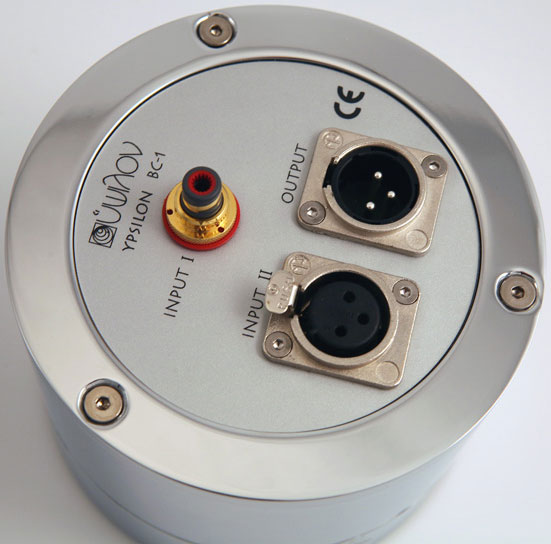
I got these things at the same time that I received the incredible Ypsilon PST 100 MK2 preamp for review. I was so preoccupied with the PST 100 itself that it took me a week to install the BC-1s. Once I did, it was fascinating to try them out in different configurations.
“Transformers” Aren’t Just a Movie
The main purpose of a balanced converter transformer is to convert an unbalanced signal to a balanced one. For example, you may have a fully balanced system except for your source, and you’d like to run fully balanced throughout. This can be especially useful for long interconnect runs between components, where your cables can act like a giant antenna system. You can keep the noise to inaudible levels.
The BC-1s also provide component isolation, which also acts to lower the noise floor of your system. There are numerous components that have XLR outputs but are not truly balanced, but there are also truly balanced components that benefit from isolation. Hence the BC-1’s female XLR input. I must say that I was surprised by the benefits of the additional isolation even in balanced systems. You would think that adding another cable and connection between two components would degrade the signal, but the opposite occurred. I’m not just talking about breaking system ground loops for I don’t have any, I mean the reduction of noise you weren’t even aware of.
On a more technical level (from the Aaudio Imports website):
“Each BC1 Transformer has Two inputs, One RCA Nextgen connector and One female XLR Neutrik connector with pin 1 and pin 3 grounded. The output connector is a XLR male Neutrik connector. Pin 1 is the center tap of the secondary coil that is connected at Pin 2 and 3 respectively. Pin 2 or pin 3 therefore should not be connected to ground.
The BC1 transformers use a proprietary high performance Cobalt based amorphous core material of very high permeability that is very linear with frequency and flux level. This specific material is regarded to be one of the best magnetic materials available today.
The BC1 transformers are optimized sonically to be as transparent as possible. In this way they can improve the performance of a system since they provide a better interface isolation between devices. The signal ground current doesn’t travel through mains chords but only through the interconnect cables, maximizing in this way the overall performance of the system.
The BC1 transformers are shielded with mu-metal and potted in 10mm soft iron with a nickel coating. Outside magnetic field interference is kept to a minimum.”
Unlike many professional converters, the BC-1 does not provide any gain, so you don’t have to recalibrate your system when it is inserted.
Experimentation
The improvements the Ypsilons wrought in my main system were subtle but clearly discernible. My first reaction was “Did anything happen?” After a few minutes my reaction was “What exactly happened?” It took some listening, followed by removal of the BC-1s to get a handle on the total effect. In a nutshell, with the BC-1s installed, there was a subtle increase in apparent detail and nuance that affected everything in every piece of music played.
I started with my main system. The most impact was obtained when the BC-1s were inserted between the Ypsilon PST 100 and my Lyngdorf RP-1 room correction device. This makes sense, because I converted the signal to balanced and also got the benefit of additional isolation. However, I also got a positive effect when inserting the BC-1s between the Lyngdorf and my monoblocks and between my Esoteric D-70 and the preamp.
I then proceeded to experiment by inserting my single-ended Marantz DV-8300 as the front-end and connecting it to several balanced preamps via the BC-1s. The effect was more pronounced than when the BC-1s were inserted between the Esoteric front-end and the Ypsilon.
Just for the heck of it, I took the BC-1s to my 2nd floor bedroom system and inserted them between the DVR and the receiver. Again, I got a subtle benefit. I then took them to my basement system and inserted them between an old Sony DSS receiver and the preamp. This time the benefit was much more pronounced, which surprised me since I had assumed that the basement system would get no benefit at all. I’m still not sure why this was the case.
Conclusion: So Who Will Use These Babies?
Now, no one will ever spend $3,600 for a pair of finely-crafted Ypsilon BC-1s to insert into a $2,000 stereo system. These are clearly meant for ultra-high fidelity systems where the owner either wants to convert a loved component’s signal to balanced and/or who will go for isolating multiple components in the system to get the absolute lowest noise floor possible. The second is obviously a very expensive proposition, since you will also then need an additional set of interconnects of a quality that is commensurate with the other cables in the system. However, if you have the dough, have already done the basic things to have a quiet system and want to go for a really vanishing (or vanished) noise floor where the music gods finally lay everything bare, these babies are your ticket to get there.
- (Page 1 of 1)